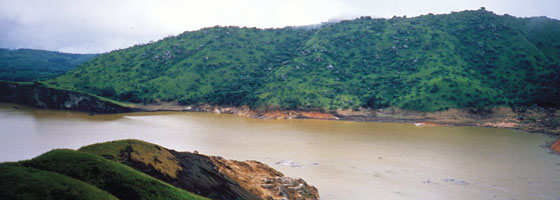Exploring Lakes at the Extremes

Lakes can be big or small, pristine or foul, and, in rare cases, even deadly. Here are some interesting facts about lakes at the extremes, courtesy of the staff at LakeScientist.com.
Exploding Lakes
A tragic phenomenon occurred in Cameroon in the mid 1980s, where lakes seemed to be mysteriously killing people. The first event happened in 1984, when 37 people near Lake Monoun died suddenly.
The second event, however, was much more deadly. In August 1986, Lake Nyos released a cloud of carbon dioxide (CO2) that hugged the ground and flowed down surrounding valleys to suffocate thousands of local villagers and animals.
Overall, more than 1,700 people were killed as far as 26 km away from the lake. A third lake, Lake Kivu, on the Congo-Rwanda border in Central Africa, is also known to act as a reservoir of carbon dioxide and methane. These three lakes contain extremely high concentrations of CO2 in their depths and can be lethal to the thousands of people who live around them. If Lake Kivu were to explode, more than two million people who live around it would be in danger.
The science behind the buildup of CO2 is relatively simple. These deep lakes occur near a dormant volcano. The real danger is generated by subsurface magma about 50 miles below the lakes. The magma releases the CO2 and other gases, which travel upward through the Earth.
The CO2, instead of being released harmlessly into the atmosphere, collects in the cold water at the bottom of the lake. The amount of gas that can be dissolved in the water is dependent on water temperature and pressure. The greater the pressure and colder the water, the more gas can be trapped.
None of this would be particularly hazardous if the water at the bottom of the lake were to rise regularly to the surface, where the gas could be released safely. The problem is that the waters of these lakes, like many tropical lakes, are usually quite still with little annual mixing of the water layers.
Over time, the lowest levels of the lakes become supersaturated with CO2. This gas can quickly escape if the lake is disturbed by a landslide, earthquake, violent storm, or other disturbance. The sudden release of CO2 can be fatal. CO2 is heavier than air, and when it was released in previous explosions it poured over the rim of the crater and down into the surrounding low-lying valleys.
Although CO2 normally makes up 0.03% of the atmosphere, concentrations of more than 10% can be fatal. The unfortunate villagers around Lake Nyos literally suffocated under the heavy poisonous cloud of CO2 gas.
Unfortunately, this problem does not yet have a solution. Scientists have installed pipes to degas the high CO2 concentrations soon after the disaster, but according to recent reports, the lake now contains twice as much carbon dioxide as was released during the explosion. Earlier attempts to siphon off the gas had to be abandoned for financial reasons.
Most Polluted Lake
Lake Karachay, a small lake in the southern Ural Mountains in western Russia, is thought to be the most polluted spot on Earth. Starting in 1951, the Soviet Union used Karachay as a dumping site for radioactive waste from Mayak, a nearby nuclear waste storage and reprocessing facility located near the town of Ozyorsk. By some estimates, the lake has accumulated roughly 4.44 exabecquerels (EBq) of radioactivity. By comparison, the Chernobyl disaster released 5 to 12 EBq of radioactivity, although this was spread over a much larger area.
Disappearing Lakes
Many lakes around the world are disappearing as water usage increases and input rivers and streams are diverted for agriculture and municipal water supply. Further, climate change is also reducing water levels in many lakes due to changes in precipitation patterns. Lake Chad, located in North Africa, is a sad but noteworthy example of this because its inflow rivers have been increasingly diverted for human use over the last several decades and less precipitation has fallen. Ironically, the name Chad is a local word meaning “large expanse of water.”
According to the United Nations, Lake Chad shrank by as much as 95 percent since 1963. Lake Chad is economically important, providing water to more than 20 million people living in Chad, Cameroon, Niger, and Nigeria.
Other Unique Lakes
Laguna Colorada, a shallow saltwater lake in Bolivia, is renowned for its red color and white islands. What makes this lake so striking is the contrast between the red microorganisms growing in the lake and the white borax and salt deposits in and around it.
The Plitvice Lakes are a series of 16 lakes connected by waterfalls. The lakes are located inside Plitvice National Park, Croatia near the border of Bosnia and Herzegovina. These lakes span a distance of more than five miles (8 km) and come in various shades of azure, green, and blue. The lakes also cross a large elevation gradient, with the highest lake at about 4,000 feet (1,280m) and the lowest at about 1,200 feet (380m). The lakes were formed by natural precipitation of carbonate minerals from ground and surface waters, called travertine and are extremely rare.
Lake Victoria, bordered by Kenya, Uganda, and Tanzania, is the largest tropical lake in the world. As recently as the mid1950s, Lake Victoria had more than 500 species of cichlids in its waters. The number of cichlids and other measures of biodiversity has rapidly dropped in recent decades due to the introduction of invasive species such as the Nile Perch and increasing human disturbance that alters water quality and transparency of the lake.
This information is excerpted from “Extreme Lakes” at LakeScientist.com. Visit the site to learn more in the “Learn about Lakes” section. Lake Scientist provides an interactive community resource focused on lakes and other freshwaters for the benefit of the scientific community, the education community, and all others interested in the subject.
Image credit: Lake Nyos, Suite101




0 comments